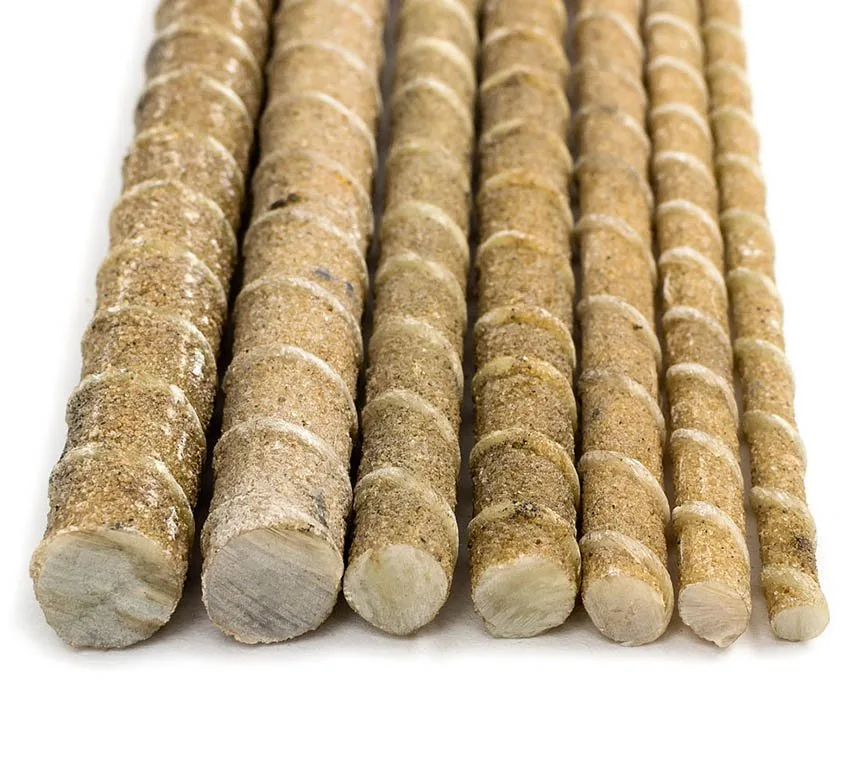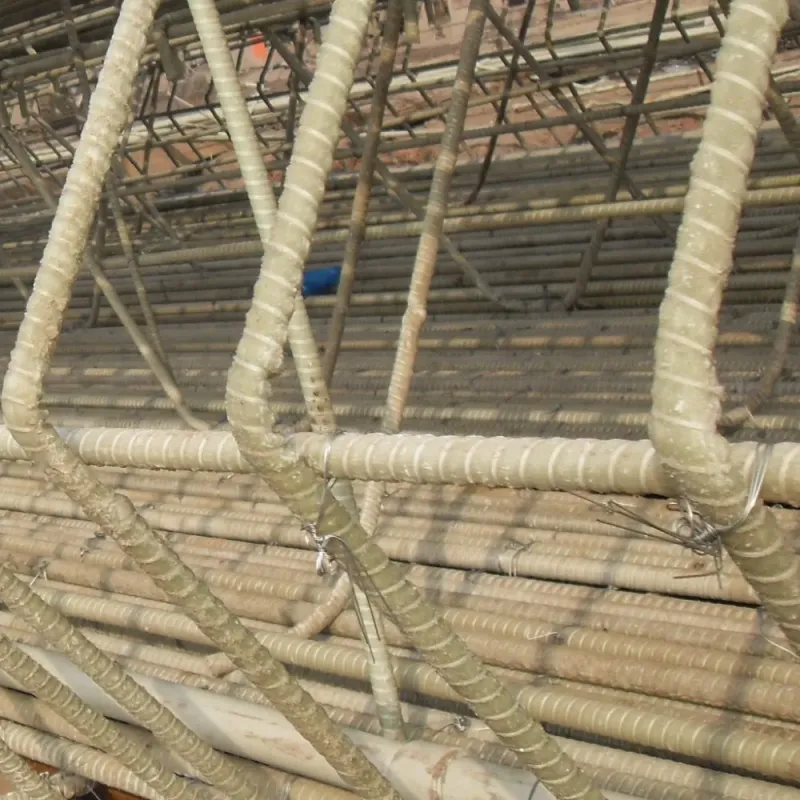Updated April 28 2025 – 8 min read
Executive Summary
If you need reinforcement that won’t corrode, weighs 75 % less, and can save 40–50 % over a 30‑year life cycle, fiberglass rebar is your strongest candidate. Steel remains the go‑to for very high‑temperature or fatigue‑critical zones. Read on for data‑driven comparisons, real‑world prices, and 2024–2025 code updates.
1. What Is Fiberglass (GFRP) Rebar?
Fiberglass rebar—formally Glass Fiber–Reinforced Polymer (GFRP) rebar—is a composite of E‑glass fibers and vinyl‑ester resin, pultruded into round bars. It is non‑magnetic, non‑corrosive, and one‑quarter the weight of steel while delivering ≥ 1 000 MPa tensile strength.

16 mm sand‑coated GFRP rebar ready for concrete pour in marine environment
2. Key Performance Comparison
| Property | GFRP Rebar | Steel Rebar |
|---|---|---|
| Specific Gravity | 1.9 | 7.85 |
| Density (kg / m³) | 1 900 | 7 850 |
| Tensile Strength (MPa) | ≥ 1 000 | 400–550 |
| Elastic Modulus (GPa) | 45–60 | 200 |
| Thermal Conductivity (W / m·K) | 0.25 | 50 |
| Electrical Conductivity | Non‑conductive | Conductive |
| Corrosion Resistance | Excellent | Susceptible |
| Weight per 10 m, Ø16 mm (kg) | 2.4 | 14.9 |
Data sources: ACI 440.6‑22, ASTM D7957‑22, Unicomposite lab tests (2024).
3. Cost Analysis Over a 30‑Year Life Cycle
| Scenario: 100 m³ RC slab, Ø16 mm @ 200 mm c/c | GFRP | Steel |
| Rebar mass (t) | 0.96 | 5.92 |
| Material unit price (USD / t, Apr 2025) | 4 000 | 850 |
| Material cost (USD) | 3 840 | 5 032 |
| Transport & handling | 500 | 1 200 |
| 30‑year maintenance (patching, rust inhibitors) | ≈ 0 | 2 500 |
| Total 30‑year cost | 4 340 | 8 732 |
Note: Prices use China FOB averages, Q2 2025. Adjust for local rates.
4. Installation & Handling
- Weight: One worker can carry three 12 m sticks of Ø16 mm GFRP; steel requires lifting gear.
- Cutting/Bending: GFRP is cut with a diamond blade and cannot be bent on‑site; use factory‑made stirrups.
- Tie‑Wire: Standard plastic‑coated wire is sufficient; no galvanic reaction with ties.
Best Practices
Keep rebar dry before placement, wear cut‑resistant gloves, and maintain a 40 × bar‑diameter straight‑length overlap per ACI 440.6‑22.
5. Compliance with International Codes
| Region | Code / Guideline | Current Edition |
| USA | ACI 440.6 Design of FRP Reinforced Concrete | 2022 |
| Canada | CSA S806 FRP Reinforcement | 2022 |
| EU | fib TG 9.3 FRP Reinforcement | Draft 2024 |
| China | JGJ 323 Technical Specification for FRP Bar RC | 2023 |
Tip for specifiers: Always check the local authority’s acceptance criteria; many permit GFRP in non‑prestressed concrete except in fire‑critical members.
6. Where GFRP Rebar Excels
- Marine & coastal bridges – zero chloride‑induced rust.
- Waste‑water plants & desalination – avoids chemical attack.
- MRI & radar facilities – electromagnetic transparency.
- Lightweight precast panels – reduces transport cost.
7. Case Study: 2024 Coastal Bridge Retrofit, Fujian, China
A 170 m river‑mouth bridge replaced corroded steel rebar with Ø20 mm GFRP. Results after 12 months:
- Dead‑load reduced 18 % on cantilever segments.
- Installation time cut by 22 % due to lighter bars.
- Predicted life extended to 75 years with no major maintenance.

Lightweight GFRP cage lowering into bridge deck formwork
8. Pros & Cons at a Glance
Advantages of GFRP
- Immune to corrosion and chlorides
- 4× tensile strength‑to‑weight ratio of steel
- Non‑conductive & non‑magnetic
- Lower logistics and installation cost
Disadvantages
- Lower modulus requires larger crack‑width checks
- Cannot be field‑bent after curing
- Higher upfront material price in some markets
- Limited fire resistance above 300 °C (use cover or intumescent)
9. Frequently Asked Questions
Can GFRP rebar entirely replace steel?
Not yet. GFRP excels in corrosive or electromagnetic-sensitive zones, but steel remains preferable in members exposed to sustained high temperatures (> 300 °C) or severe fatigue cycling.How do engineers account for GFRP’s lower modulus?
Designers use higher reinforcement ratios or closer bar spacing to keep crack widths within code limits. ACI 440.6 provides adjustment factors, and spreadsheets are available for rapid checks.Is fire resistance a critical issue?
At service temperatures below 200 °C, GFRP retains most of its strength. For elements that may reach higher temperatures, designers specify extra concrete cover, fire-rated board, or a composite cage that includes partial steel.What design codes recognize GFRP today?
ACI 440.6-22 (USA), CSA S806-22 (Canada), JGJ 323-2023 (China), and the draft fib TG 9.3 (EU) all provide calculation methods. Many local building departments accept GFRP when referenced to these standards.Does GFRP always cost more than steel?
Per tonne, yes. Per finished project, often no—lighter bars cut transport, labor, and long-term maintenance, delivering roughly 10–30 % lower life-cycle cost.Can I bend GFRP bars on site?
No. Bars must be pultruded or factory-formed to shape. Standard practice is to order prefabricated stirrups, hooks, and cages.How is bond to concrete ensured?
Manufacturers use sand coatings, helically wrapped fibers, or deformed surface ribs. Pull-out tests per ASTM D7957 show equal or better bond strength than deformed steel.Is GFRP environmentally friendly?
Life-cycle analyses indicate a 20–30 % lower global-warming potential (GWP) than epoxy-coated steel, thanks to reduced mass and zero corrosion-related repairs. End-of-life material can be crushed and used as filler, though full closed-loop recycling into new bar is still under development.
10. Conclusion
For structures fighting corrosion, GFRP rebar delivers lifetime savings and reliability that conventional steel struggles to match. Steel still rules in high‑temperature, dynamically loaded, or budget‑constrained projects. By combining both materials strategically, engineers can achieve optimal safety, durability, and cost performance in 2025 and beyond.Need project-specific advice? Message our FRP engineering team today for a fast, no-obligation specification and price quote.
References
- ACI Committee 440. Guide for the Design and Construction of Concrete Reinforced with FRP Bars, ACI 440.6‑22.
- ASTM D7957‑22. Standard Specification for Solid Round Glass‑Fiber‑Reinforced Polymer Bars for Concrete Reinforcement.
- CSA S806‑22. Design and Construction of Building Components with Fibre‑Reinforced Polymers.
- D. Bank et al. “Service Life Prediction of GFRP Rebar in Marine Concrete.” Composite Structures 301 (2023): 117040.
First published 2022-07-20, last updated 2025-04-28
 info@unicomposite.com
info@unicomposite.com


























